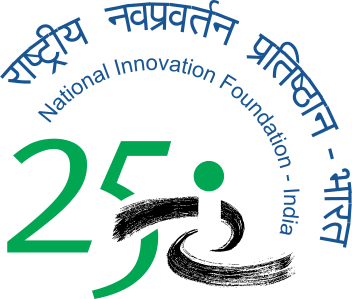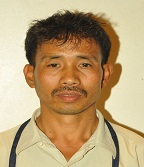Double shuttle loom
Genesis of the innovation
Being a truck driver, Nabakumar many times had to be away from home for weeks all together. His mother remained unhappy and worried all this while. She forced him to quit and take up other local engagements after his marriage. His wife had brought a traditional loom with her and he had also been looking for options for work. Given his modest carpentry experience, he thought of improving the old shuttle loom to enhance productivity and also to reduce labour intensity. But he soon realised that looms were different than what he had made earlier. He started looking for a teacher who could teach him the nitty-gritty of shuttle loom making. Elders from the village advised him to consult Asem Ibopisak Singh from a nearby village who was an expert in loom construction. Ibopisak mentored him for many years. Thereafter, he started working on his innovation of double shuttle loom, popularly known as ‘Panthoibi Loom’. It again took a couple of years of trial and error but he finally got the combination right in 2008. In Nabakumar words, it has been a journey of unpredictable need. He went through all possible struggles in life while developing the device. His major challenge while developing the double shuttle loom was in regard to the movement and synchronization of two shuttles. He had sleepless nights during development of the loom and even had quarrelled with his wife that he could not operate double shuttle loom. But he was adamant to see his innovation operational. He shares that his wife really supported him at all stages of innovation. His mentor, Asem Ibopisak Singh, supported him with prompt guidance all throughout. He was also supported financially at times by the owner of the truck he drove, Jonathan. Once, happy with his loyal service, Jonathan gifted him truck full load of wood for his loom experimentation. It was then when his work really picked up.
The Double Shuttle Loom
The innovation is a modified loom, which is only slightly bigger in shape due to the incorporation of the second shuttle. The technical details remain more or less the same with the existing shuttle loom models. In the conventional shuttle looms a shuttle passes from one side to the other of the warp shade, running on the warp beam. A small rob/string is used to pull the shuttle from side to side. A horse shoe shape slider, commonly made of hard leather, fixed on the end arms of warp beam, pushes the shuttle to and fro from one end to the other. In the double shuttle loom, there is a common horse shoe in the middle. When the first shuttle strikes from one end, the middle horse-shoe strikes the second shuttle in the same direction. Therefore, both the shuttles move in the same direction simultaneously and the middle horse–shoe strikes one shuttle at a time. Many ball bearings have also been added to the new machine. Therefore weaving on the double shuttle loom has become easier than any other single shuttle loom. Apart from the double shuttle loom, he also developed certain accessories to further ease work on the double shuttle loom.
Warp Winding Drum for Double Shuttle Loom ( Khangjeng drum)
Nabakumar developed this double warp winding machine to accommodate two warp rolls simultaneously. It works in the same principle of any other warp winder. There is no extra effort required and the improved rolling mechanism with ball bearings makes the machine very light to rotate. Double Bobbin Spinning Charkha (Silheima Tareng) This charkha was developed to facilitate spinning of bobbins for his double shuttle loom. The device follows the same principle of any other shuttle loom except that it spins two bobbins simultaneously. With the same amount of labour input and time, one gets double the output. NIF has provided financial assistance to develop the product further.
Advantages
The double shuttle loom is probably the only treadle operated shuttle loom with double shuttles. Because of the double shuttles, the output is double than any other normal loom as it weaves two fabrics at a time, with marginal increase in cost. More over, this loom reduces the time consumption and needs fewer efforts for weaving as well. Another advantage is that the machine can accommodate other advanced machineries like jacquard machine or “Chanakee” to enhance productivity level in design fabrics. If these devices are incorporated, then the earnings would go up many folds. As it is operated like any other traditional loom, it does not require any special training. If well diffused, his machine has the promise of a secured livelihood for many. Nabakumar has sold a few units of the double shuttle loom recently. A woman group has also purchased some looms from him, the feedback of which has been quite promising. The Directorate of Commerce and Industries, Government of Manipur has also purchased ten pieces of looms. NIF has also filed a patent application in the name of innovator (203/KOL/2011). Nabakumar was also invited by NIF to participate in the innovation exhibition in 2011 at Rashtrapati Bhawan Delhi where the machine received wide attention. Nabakumar dreams to have his own enterprise out of his innovation. He has the following to say to his fellow innovators, “let’s make our land a prosperous one by inventing new things”.
Noticing the problems in traditional shuttle loom, Nabakumar (42 years) thought of improving it to enhance productivity and reduce labour. His ‘double shuttle loom’ works on the same principle as that of any other standard manual shuttle loom but is wider with the provision for two sets of warp rolls resulting in double output in a given time.
Nabakumar Singh, a driver and a carpenter, was born in a farmer’s family. Poverty did not allow him to study beyond class third. Though he dropped out from school quite early, he has clear memories of school life even now. He was a top ranker, the monitor of his class and wanted to become a professional footballer. He started helping his father in his paddy field but kept on continuously thinking ways to support the family financially. After a few years, he took up driving as the profession and became the driver of a local doctor. He also drove trucks and during rainy season worked as carpenter making furniture. Presently, Nabakumar is fully engaged in the constructing double shuttle loom and its accessories. His wife is involved in weaving of traditional clothes using his double shuttle loom.







.jpg)
